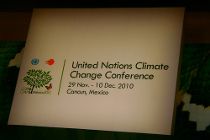Cancun is going green from the bottom-up
With the 16th Conference of Parties (COP16) in Cancun underway, this year’s summit could be distinguishable by a new bottom-up approach to dealing with climate change.

With the 16th Conference of Parties (COP16) in Cancún underway, this year's summit could be distinguishable by a new bottom-up approach to dealing with climate change. As reported in the article solar power on the agenda at COP16, the solar industry will lobby delegates to urge for an accelerated use of solar energy.
This seems to be part of a wider strategy, moving away from the traditional top-down method preferred by the UN. The origins of this strategy can be traced back to COP15, when countries failed to consent to binding agreements on climate change targets.
With much the same expected at COP16, investors and entrepreneurs such as Sir Richard Branson and Ted Turner are expected to attend COP16. This gives it the perception of a more collaborative effort between stakeholders, rather than just a meeting between government power brokers.
Indeed, both Branson and Turner are due to speak at the inaugural World Climate Summit (WCS), on 4-5th December at the Ritz-Carlton in Cancun. The event is a forum designed to accelerate solutions to mitigate climate change. Its purpose is to exchange ideas and to provide a collaborative platform for the private and public sector to implement policies from the bottom-up. Cutting across sectors and businesses, investors and governments it is scheduled to run every year for the next 10 years, in parallel with the annual COP meetings.
The major advantage of the bottom-up approach is its flexibility. It is not limited to large industry or to the WCS. It is ideal for individuals who are quick to react and spot gaps within the marketplace, as the method does not rely on layers of bureaucracy.
Unlike the top-down method that saw nations failed to agree to binding limits at COP15, the bottom-up method seeks to implement solutions without the necessity for such binding limits. The method can work in any organisation, even those where green changes encounter stiff resistance.
Those who know their business best are in the best position to advise on green practices. Known as a grass roots trend - letting innovative employees dictate green policies – there can initially be resistance from sceptics. Ideas can be as small as implementing a recycling policy for paper, bottles and cans and as bold as compiling a list of eco-friendly retailers and urging employees to buy from them.
However, it is collaboration between non-governmental organisations and businesses that drives the bottom-up approach. In October the United Nations Environment Programme (UNEP) announced a partnership with Asian and African Development banks, with the objective of getting seed capital to clean energy entrepreneurs.
The Seed Capital Assistance Facility (SCAF) is designed to help stimulate renewable energy and energy efficiency ventures in the developing world.
"Entrepreneurs can transform markets, but the environment for entrepreneurship remains weak in many countries, particularly in the energy sector." said UNEP's Executive Director Achim Steiner, in an official press release. "New ventures often lack business development support and seed financing is hard to secure," Steiner added.
The facility is in place because of the reluctance to invest in low carbon energy sectors too early. The SCAF addresses these issues by helping private equity fund managers provide seed financing and business assistance to early stage clean energy projects and enterprise developments.
Additionally, Donald Kaberuka, President of the African Development Bank, said that this facility is helping African entrepreneurs "jump-start new ventures aimed at solving the continent's energy deficit." SCAF is bringing vitality to Africa's high potential renewable energy sector, he said.
Six fund managers have been engaged to date in Asia and Africa, employing a range of early stage investment strategies. This example of SCAF, as well as the World Climate Summit, shows that green minded individuals need not wait for government legislation or intervention in order to implement green policies.
Author: Leroy Robinson | Climate Change
Image: linh.m.do | Flickr






